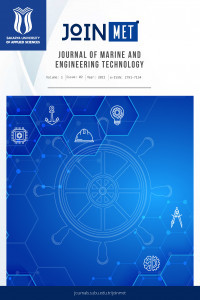Optimization Of The Laser GMA Hybrid Welding Parameters Using Genetic Algorithm
Mathematical Modeling, Genetic Algorithm, Open Source, Matlab Codes
___
- 1.Taguchi, G. (1990). Introduction to quality engineering, Tokyo. Asian Productivity Organization, 4(2), 10-15.
- 2.Ross, P. J. (1996). Taguchi techniques for quality engineering: loss function, orthogonal experiments, parameter and tolerance design.
- 3.Kim, H. R., Park, Y. W., & Lee, K. Y. (2008). Application of grey relational analysis to determine welding parameters for Nd: YAG laser GMA hybrid welding of aluminum alloy. Science and Technology of Welding and Joining, 13(4), 312-317.
- 4.Perez Pozo, L., Olivares Z, F., & Durán A, O. (2015). Optimization of welding parameters using a genetic algorithm: a robotic arm–assisted implementation for recovery of Pelton turbine blades. Advances in Mechanical Engineering, 7(11), 1687814015617669.
- 5.Kim, I. S., Son, J. S., Park, C. E., Lee, C. W., & Prasad, Y. K. (2002). A study on prediction of bead height in robotic arc welding using a neural network. Journal of Materials Processing Technology, 130, 229-234.
- 6.Lee, J. I., & Rhee, S. (2000). Prediction of process parameters for gas metal arc welding by multiple regression analysis. Proceedings of the Institution of Mechanical Engineers, Part B: Journal of Engineering Manufacture, 214(6), 443-449.
- 7.Meseguer-Valdenebro, J. L., Portoles, A., & Matínez-Conesa, E. (2018). Electrical parameters optimisation on welding geometry in the 6063-T alloy using the Taguchi methods. The International Journal of Advanced Manufacturing Technology, 98(9), 2449-2460.
- 8.Nagesh, D. S., & Datta, G. L. (2010). Genetic algorithm for optimization of welding variables for height to width ratio and application of ANN for prediction of bead geometry for TIG welding process. Applied soft computing, 10(3), 897-907.
- Başlangıç: 2021
- Yayıncı: Sakarya Uygulamalı Bilimler Üniversitesi
An Overview of Environmental Impacts and Treatment Systems of Ship Ballast Waters
Mehmet DOĞRU, Seyid Mahmud Esad DEMİRCİ, Refik CANIMOĞLU, Hüseyin ELÇİÇEK
AHP And Grey Relations Analysis Based Boat Selection For Summer Tourism Activities
Muhammet Enes AKPINAR, Mustafa GERŞİL
Optimization Of The Laser GMA Hybrid Welding Parameters Using Genetic Algorithm
Ömer Faruk DEMİROK, Osman ÜNAL
Modeling of Diesel Engine Performance and Emission Using Artificial Neural Networks
